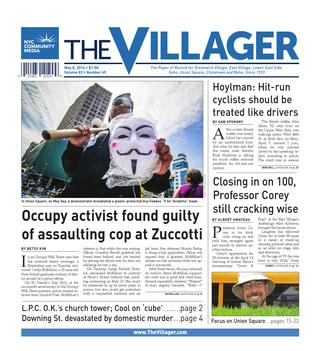It almost seems as if there’s been a Canal St. traffic study for every car on the street.
The roadway has long been a source of government-funded efforts — some with catchy acronyms like CATS, the Canal Area Transportation Study — so it was not surprising Canal is one of the 13 streets the city is trying to make safer with an “arterial slow zone.”
Of the targeted areas, Canal is the deadliest per mile, according to the statistics the city Department of Transportation released with last week’s announcement about the zones.
While other city streets, like Queens Boulevard and Atlantic Ave. in the Bronx, have seen many more deaths since 2008 (23 and 25, respectively) than Canal’s six, they’re about a death-per-mile lower than the 4-to-1 ratio on Canal’s shorter, one-and-a-half-mile stretch.
And although there were six deaths too many on the Lower Manhattan street, that was actually a vast improvement over some years ago when there were 14 deaths over the six years ending in 2001.
The slow zone will have a modest drop in speed limit from 30 to 25 miles per hour, but even more important, there will be speed-limit signs, more enforcement and focus.
The last one is probably the most important, because the reality is speeding is not the big problem on Canal.
No doubt, many frustrated drivers turning off the West Side Highway waiting to get into the Holland Tunnel, or stuck as they wait to cross the Manhattan Bridge, would be willing to pay the price of a speeding ticket if that would get them moving faster.
The street is a clear physical barrier that also literally divides Community Boards 1 and 2. That is one of the reasons that Lower Manhattan school advocates don’t see a proposed school just near Canal as a solution to school overcrowding problems because it would mean students as young as age 4 would be crossing the thoroughfare.
Vehicles so dominate the area that they overwhelm pedestrians trying to cross the five to seven lanes of two-way traffic, or the long intersection at Hudson St. that sandwiches the tunnel entrance.
There have been minor tweaks to the street over the years, which probably have helped reduce the death rate.
Still, what is clear is that daily many people are visibly in fear because they walk so cautiously when crossing.
What’s needed is larger, more prominent crosswalks to send the unmistakable Ratso Rizzo message to drivers: “Hey! I’m walkin’ here!” (Dustin Hoffman’s most famous line from “Midnight Cowboy” was ad libbed when an impatient New York cabbie almost ran him over during filming.)
Northern Boulevard, the site of D.O.T.’s slow zone announcement, will also be getting safer crosswalks at an intersection near a school. It is almost undoubtedly needed there, although it is notable that the boulevard’s zone is almost three times the length of Canal but has had one fewer death since 2008, five.
As of now, there are no plans for additional safety measures in Lower Manhattan.
The focus and stepped-up enforcement on Canal will unquestionably help. It’s all part of Mayor de Blasio’s worthy Vision Zero goal of eliminating all traffic deaths.
In a practical sense, adding signs will make the speed limit drop infinite since many city drivers are unaware of a specific limit because they rarely see a sign.
The arterial slow zone will be a big improvement, nevertheless, more will still need to be done. However, the city is thankfully moving in the right direction by implementing the Canal St. slow zone.


















